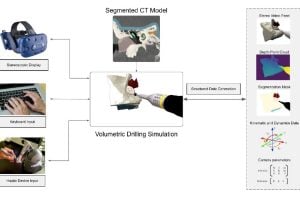
People with diseases or conditions that affect the base of the skull, such as otologic abnormalities, cancerous tumors and birth defects, might need to undergo skull base surgery at some point in their life. To successfully conduct these challenging procedures, surgeons must skillfully operate on and within a person’s skull, accessing specific regions using drills.
Researchers at Johns Hopkins University (JHU) have recently developed a new system that could be used to train surgeons to complete skull base surgeries, as well as potentially other complex surgical procedures. This system, presented in a paper published in Computer Methods in Biomechanics and Biomedical Engineering: Imaging & Visualization, is based on the use of a virtual reality (VR) simulator.
“The process of drilling requires surgeons to remove minimal amounts of bone while ensuring that important structures (such as nerves and vessels) housed within the bone are not harmed,” Adnan Munawar, one of the researchers who developed the system, told TechXplore. “Therefore, skull base surgeries require high skill, absolute precision, and sub-millimeter accuracy. Achieving these surgical skills requires diligent training to ensure the safety of patients.”
Currently, most resident surgeons are trained to complete skull base surgeries and other procedures on cadavers or on live people under the supervision of experienced doctors. However, realistic computer simulations and virtual environments could significantly enhance the training of surgeons, offering a cost-effective, safe and reproducible alternative to traditional training methods.
In addition to allowing surgeons to practice their skills in a safe and realistic setting, simulation tools enable the collection of valuable data that would otherwise be harder to attain. This includes optimal trajectories for surgical tools, the forces that are imparted during a procedure, or the position of cameras/endoscopes.
“This data is beneficial for two purposes,” Munawar explained. “Firstly, it could be used to train artificial intelligence (AI) algorithms that can assist surgeons in the operating room and make procedures safer. Secondly, by comparing surgical data from residents in training and expert surgeons, educators could individualize training and make the limited time trainees have for education more efficient.”
Read the full article here: https://techxplore.com/news/2021-12-virtual-reality-simulator-surgeons-skull-base.html